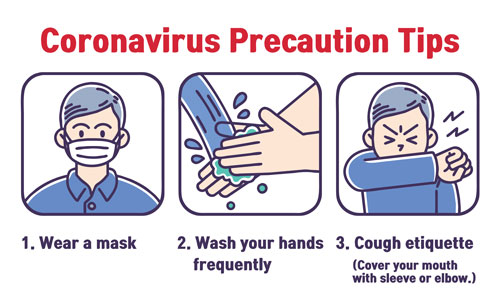
COVID-19 (SARS-CoV-2) Medical Update 3.20.20 Why I am practicing “Shelter in Place.”
Corona virus (has a plasma membrane outer envelope) is easily killed by:
1. Soap or Detergent (wash hands for 20 seconds)
2. Windex (contains detergents)
3. Bleach
4. Ethanol or Isopropanol 60-80% (alcohol – at least 60%, most wipes are 70%)
How long can the virus live on the surface of an object (Fomites)? Hours to Days; depends on the study and weather. In one laboratory test:
1. Copper and Cardboard (boxes and paper tissue) – up to 24 hours
2. Steel and Plastic – up to 48 hours
The US is still early in the pandemic process. Half of infected individuals will not have symptoms. We can protect ourselves against any undetected spreaders by keeping our hands and common surfaces clean, and maintaining 6 feet distance when we talk (optional-use of face masks). The risk of infection from direct personal contact is lower than from touching fomites (infected surfaces and objects), statistically per the number of people touching the object between cleanings.
The medical estimate is that 5% of all infected individuals (not diagnosed) will require hospitalization (this means 95% will NOT need to go to the hospital) and 2.5% will require the ICU (intensive care unit for a respirator). The average ICU stay is 3 weeks and starts a 1 week after the diagnosis. Without public protective measures, the course of infection with Coronavirus doubles each week. The biggest surge of infections in the US would occur in weeks 5/29 and 6/5 when 25% of the population gets infected each week. Our hospital system cannot care for these large numbers. If, we as a people can slow down the doubling time from 1 week to >8 weeks; this “flattening of the curve” will allow our medical care system to at least have room capacity, equipment and staff to deliver care. The death rates from Corona virus (is similar to the seasonal Flu): 1.4% in 60-69 y/o, 4.8% in 70-79 y/o, and 8.23% in the over 80 years of age group.
The next month is critical: March 16 to April 16. It’s not so dangerous in terms of getting infected personally, but important for flattening the curve. We need to follow these 3 principles:
1. Social Distancing
2. Fast Testing
3. Immediate Quarantining
If we are still doubling each week on April 16, we still have a second chance. If that doesn’t work by May 16, there needs to be extreme measures such as central quarantine for the sick and enforced home-isolation for everyone else (China and Italy level extreme measures and enforcements). I do take heed that Anthony Fauci (director of the National Institute of Allergy and Infectious Diseases) has said recently that “we should be in lock down right now, because otherwise, it is not drastic enough.”
Our media and communications should identify scientific and medical leaders who can regularly address the country with accurate information and guidance. The US knew Corona virus was coming. (I was taken back by our slow start – unbelievable with our knowledge). The fact that the CDC was stuck on using PCR technology, on a specific model of machine to be run overnight, not designing the right primers; demonstrates a rigid system that needs change. The fact that it took a month to figure out the US testing plan was not going to work, tells me a single person or entity cannot have full control. A collaborative team approach is needed; I am thankful that is happening now at lightning speed! Thank you to Dr. Lin from Stanford for sharing research.
At the first sign of CoVID19 symptoms, stay away from others and get tested (“self-quarantine”). Put on a mask and keep your hands clean until you know your test results.
Strict Hygiene Recommendations:
1. Don’t shake hands – I use a “shaka,” pendulum, circle, royal wave (pronate/supinate), or bow! Skip the elbow bump for hugs, you need to keep a 6 feet distance.
- Beyond ”wash your hands often” and “don’t touch your face” – implement strict hygiene by treating your hands and objects the same:
- Sanitize your hands immediately before eating and immediately after touching things touched by others to avoid giving yourself viruses.
- Use clean hands to touch others’ things or when handling things to others.
- Sanitize objects given to you and only pass objects that have passed your own cleanliness test to others. (e.g. I have my hand sanitizer bottle open and ready to clean my credit card immediately after I get them back from cashiers, before I put it back in my wallet.)
- Sanitize smooth surfaces you will touch directly with your hands (e.g. tables and chair edges, wherever you put your phone and computer).
- Use paper towels to turn off faucets and open bathroom doors.
- Use gloves to open delivered package outside, putting the cardboard packaging in an outdoor recycling bin, and then wiping down the contents with disinfectant.
- To reduce the number of times I have to sanitize, I keep track of whether clean objects and hands stay clean. As long as my hands or my objects have not encountered unknown/dirty things after their last cleaning, no need to reclean. Perform immediate sanitation of hands after touching things of unknown cleanliness, so you can resume using your clean things without worry.
- Sanitization can be done by soap and water (hands) or hand sanitizer (hands or objects) or Windex (objects).
- Create “Clean Zones” – your house, your office, your car.
- If your hands are clean, you can touch your face! But remember to sanitize your hands before you touch other people’s stuff.
Activities: “Shelter in place”
If you are young, the worry is more about transmitting virus to older people than about yourself.
- So far, you can go out, to buy essentials, get takeout; if you practice strict hygiene against transmission
- You can go to your workplace, if you are primarily alone, can avoid groups, and use strict hygiene.
- “Shelter in place” means no in-person interactions. If you see select friends and family who are not sick; you must confirm that both parties adherence to strict hygiene.
- Don’t share food.
You want to be extremely careful if they live with older people, especially over 80.
- Do safer activities – this is not the time you want to break a leg and have to go to the hospital!
Travel:
Essential flights (e.g. Students need to go home) need high vigilance to hygiene. There are many points for exposure (your ID at the TSA checkpoint, can of soda from the flight attendant). Sanitizing surfaces you touch now include airplane trays, seat belts, armrests. Keeping your hands clean before touching your own things now means washing hands after closing the airplane bathroom door, (because you don’t want germs on your zippers) and washing hands after finishing. Open the door with a napkin to exit. Keep the ventilation nozzle is on full blast (it puts out HEPA-filtered air).
Mask:
The use is controversial because of the limited supply in the US. To assure those who need masks most get them, try to use them only when needed, and buy a small supply. It is better to do social distancing without masks than social crowding with masks. (In Asia, most people use public transportation and the authorities handed out masks.)
- 2 ways to get the virus:
1. Contact and ingestion
2. Inhalation of airborne droplets
- Regular disposable surgical masks are helpful because the Corona virus mode of spread is mostly through larger droplets. Disposable masks act as filters to catch bacteria and droplets in a meshwork of polypropylene; absorbing 95% of exhaled droplets from infected people. They do not completely filter out aerosolized viruses (individual viruses in a small water shell), like the N95 mask. Some evidence exists that SARS-CoV-2 can be aerosolized.
- Masks also absorb droplets during inhalation and is believed to cut transmission within households with lots of viral droplets by 60-80%.
At current infection rates and in normal activities, most people would be wasting masks. However, masks would be useful in:
-
- confined places with strangers (airplane, train, hospital or clinic).
- at-risk people, i.e. immunocompromised or elderly, in public.
- If the infection rates climb, then they would be useful for everybody out in public.
- absolutely recommended for people who are sick for avoid transmitting viruses.
- Everyone has a different risk; there should be no stigma/shaming of people wearing masks.
Hope:
- Half of all people with the virus will have no symptoms but will become immune just like most clinically infected people.
- Farmers, truckdrivers, and store workers are working. You don’t need to buy everything.
- If we do our part to reduce the speed and percentage of individuals infected this year; we will have treatments and possibly a vaccine available for when the next wave of this virus hits.
Recipe for Hand Sanitizer:
· Mix two parts 95% non-denatured ethanol or 99-100% isopropanol
· with one part 90- 100% glycerol.
Hand sanitizer (is just 60-70% ethanol with moisturizers)
The ethanol you want to use is 95% non-denatured ethanol.
Isopropanol can be substituted for ethanol, but just takes longer to evaporate. 60-70% isopropanol is just as effective as 60-70% ethanol as a disinfectant. 99-100% isopropanol (rubbing alcohol) can be purchased by the consumer as a cleaning and disinfecting agent.
The moisturizer can be glycerol or aloe vera gel (commonly used in moisturizers and makeup).
Use sanitizer for when you cannot soap and water (like when using a credit card).
COVID-19 is the WHO term for the disease, or “a positive 2019 coronavirus laboratory test regardless of symptoms.” It is helpful to think of this disease like a SARS#2 (severe acute respiratory syndrome); since this virus is so similar (96% nucleotide sequence identical) to the SARS 2013 (RNA virus). There is a large amount of research already done including multiple drugs already effective on SARS, that we will likely benefit from.
There are a family of Coronaviruses that already cause disease in humans, including the common cold. Corona viruses hop between species; such as from camels to humans (MERS-CoV), and bats to humans (SARS-CoV and today’s Corona virus).
